Financial Reports: Income Statement and Balance Sheet Analysis
VerifiedAdded on 2021/02/19
|10
|2084
|109
Report
AI Summary
This report delves into the preparation and analysis of financial statements, crucial for understanding a company's financial performance. It covers the creation of income statements, balance sheets, and cash flow statements, essential components for assessing a company's profitability, financial position, and cash flow activities. The report includes practical examples from Twinkle Toes Shoe Shop and Brisbane Camping World, demonstrating the application of accounting principles and the interpretation of financial data. It explores key financial concepts such as assets, liabilities, owner's equity, and the use of general ledgers. The report emphasizes the importance of financial statement analysis for predicting future performance, identifying potential issues, and making informed business decisions, supported by references to relevant academic literature.

Financial Reports
Paraphrase This Document
Need a fresh take? Get an instant paraphrase of this document with our AI Paraphraser
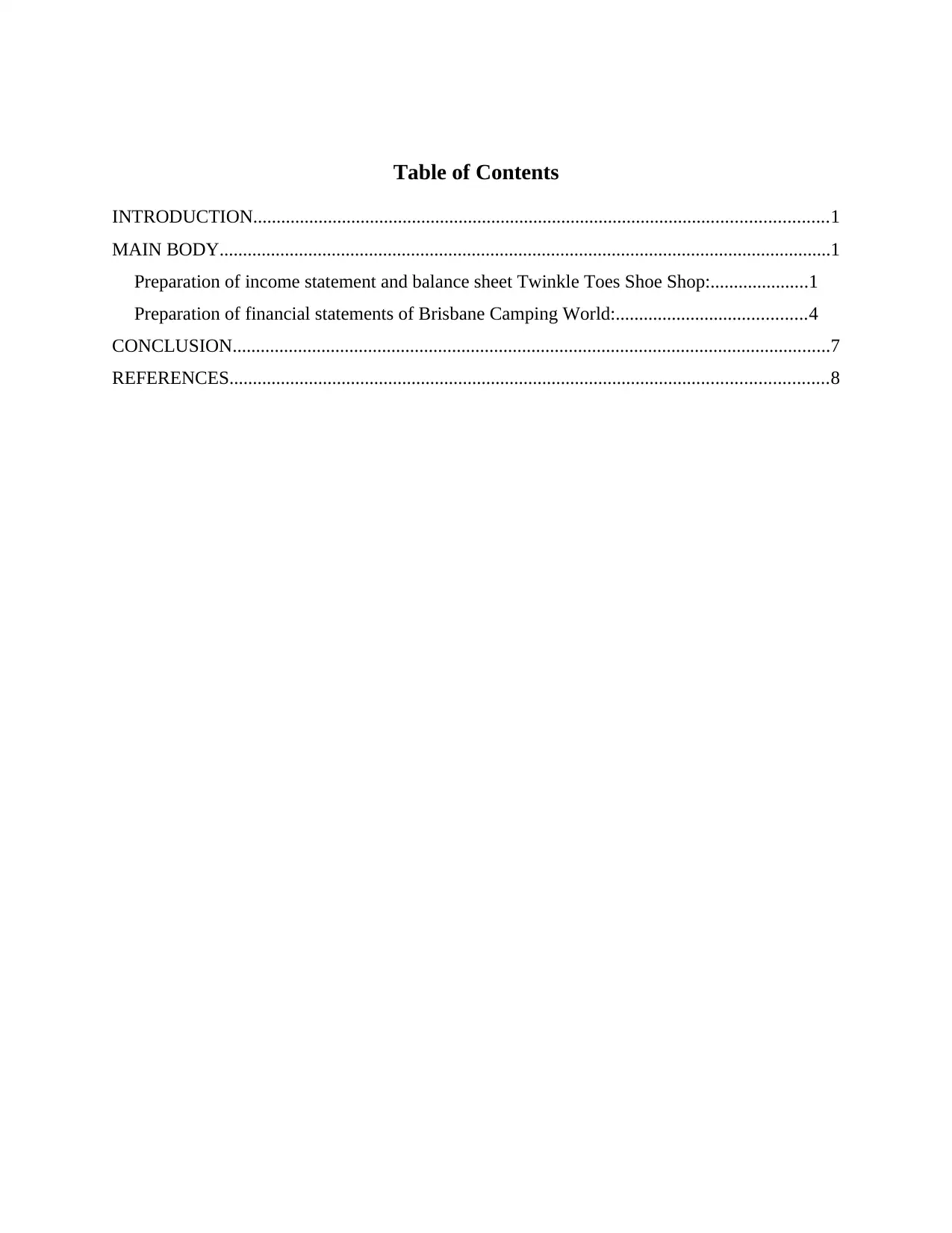
Table of Contents
INTRODUCTION...........................................................................................................................1
MAIN BODY...................................................................................................................................1
Preparation of income statement and balance sheet Twinkle Toes Shoe Shop:.....................1
Preparation of financial statements of Brisbane Camping World:.........................................4
CONCLUSION................................................................................................................................7
REFERENCES................................................................................................................................8
INTRODUCTION...........................................................................................................................1
MAIN BODY...................................................................................................................................1
Preparation of income statement and balance sheet Twinkle Toes Shoe Shop:.....................1
Preparation of financial statements of Brisbane Camping World:.........................................4
CONCLUSION................................................................................................................................7
REFERENCES................................................................................................................................8
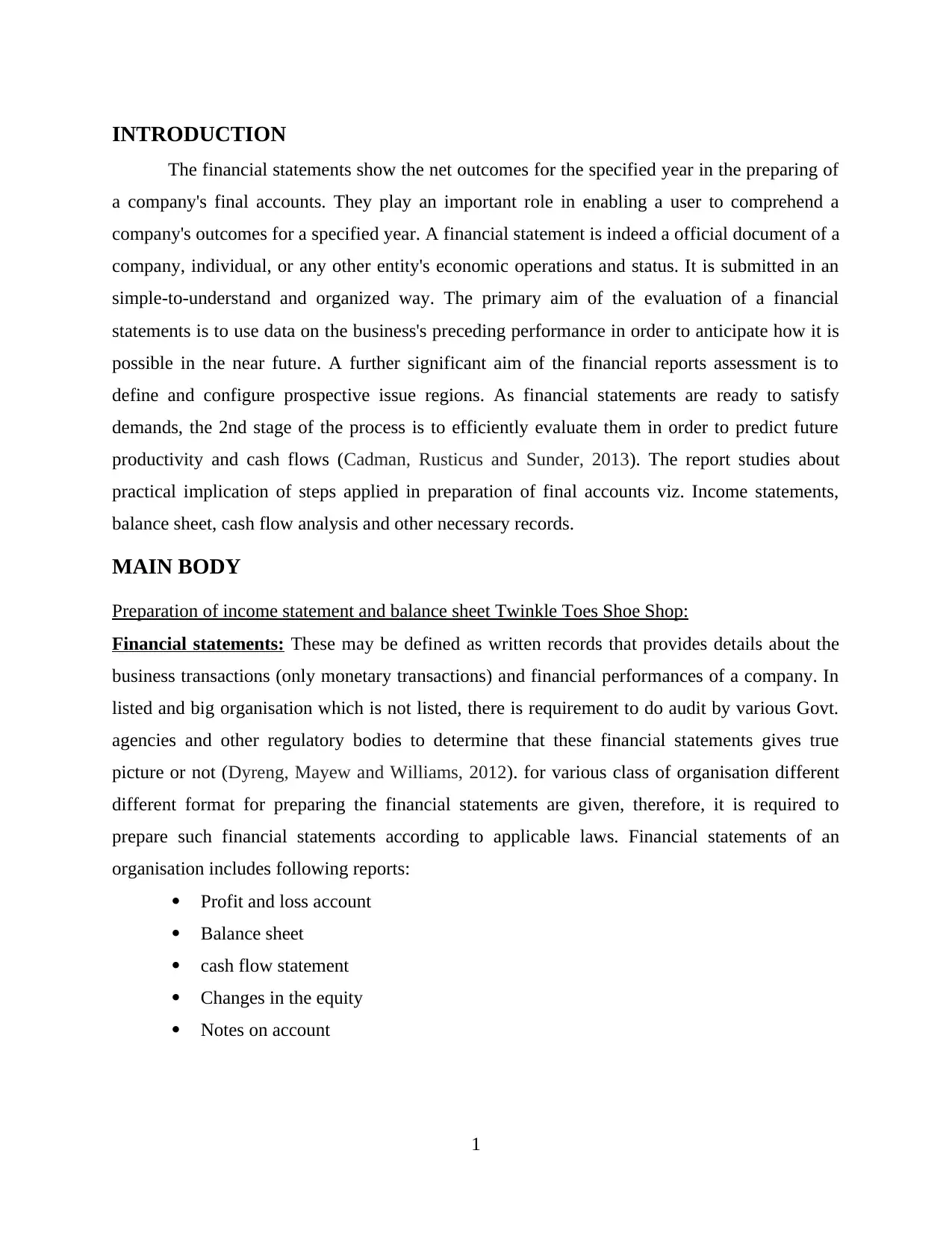
INTRODUCTION
The financial statements show the net outcomes for the specified year in the preparing of
a company's final accounts. They play an important role in enabling a user to comprehend a
company's outcomes for a specified year. A financial statement is indeed a official document of a
company, individual, or any other entity's economic operations and status. It is submitted in an
simple-to-understand and organized way. The primary aim of the evaluation of a financial
statements is to use data on the business's preceding performance in order to anticipate how it is
possible in the near future. A further significant aim of the financial reports assessment is to
define and configure prospective issue regions. As financial statements are ready to satisfy
demands, the 2nd stage of the process is to efficiently evaluate them in order to predict future
productivity and cash flows (Cadman, Rusticus and Sunder, 2013). The report studies about
practical implication of steps applied in preparation of final accounts viz. Income statements,
balance sheet, cash flow analysis and other necessary records.
MAIN BODY
Preparation of income statement and balance sheet Twinkle Toes Shoe Shop:
Financial statements: These may be defined as written records that provides details about the
business transactions (only monetary transactions) and financial performances of a company. In
listed and big organisation which is not listed, there is requirement to do audit by various Govt.
agencies and other regulatory bodies to determine that these financial statements gives true
picture or not (Dyreng, Mayew and Williams, 2012). for various class of organisation different
different format for preparing the financial statements are given, therefore, it is required to
prepare such financial statements according to applicable laws. Financial statements of an
organisation includes following reports:
Profit and loss account
Balance sheet
cash flow statement
Changes in the equity
Notes on account
1
The financial statements show the net outcomes for the specified year in the preparing of
a company's final accounts. They play an important role in enabling a user to comprehend a
company's outcomes for a specified year. A financial statement is indeed a official document of a
company, individual, or any other entity's economic operations and status. It is submitted in an
simple-to-understand and organized way. The primary aim of the evaluation of a financial
statements is to use data on the business's preceding performance in order to anticipate how it is
possible in the near future. A further significant aim of the financial reports assessment is to
define and configure prospective issue regions. As financial statements are ready to satisfy
demands, the 2nd stage of the process is to efficiently evaluate them in order to predict future
productivity and cash flows (Cadman, Rusticus and Sunder, 2013). The report studies about
practical implication of steps applied in preparation of final accounts viz. Income statements,
balance sheet, cash flow analysis and other necessary records.
MAIN BODY
Preparation of income statement and balance sheet Twinkle Toes Shoe Shop:
Financial statements: These may be defined as written records that provides details about the
business transactions (only monetary transactions) and financial performances of a company. In
listed and big organisation which is not listed, there is requirement to do audit by various Govt.
agencies and other regulatory bodies to determine that these financial statements gives true
picture or not (Dyreng, Mayew and Williams, 2012). for various class of organisation different
different format for preparing the financial statements are given, therefore, it is required to
prepare such financial statements according to applicable laws. Financial statements of an
organisation includes following reports:
Profit and loss account
Balance sheet
cash flow statement
Changes in the equity
Notes on account
1
⊘ This is a preview!⊘
Do you want full access?
Subscribe today to unlock all pages.

Trusted by 1+ million students worldwide
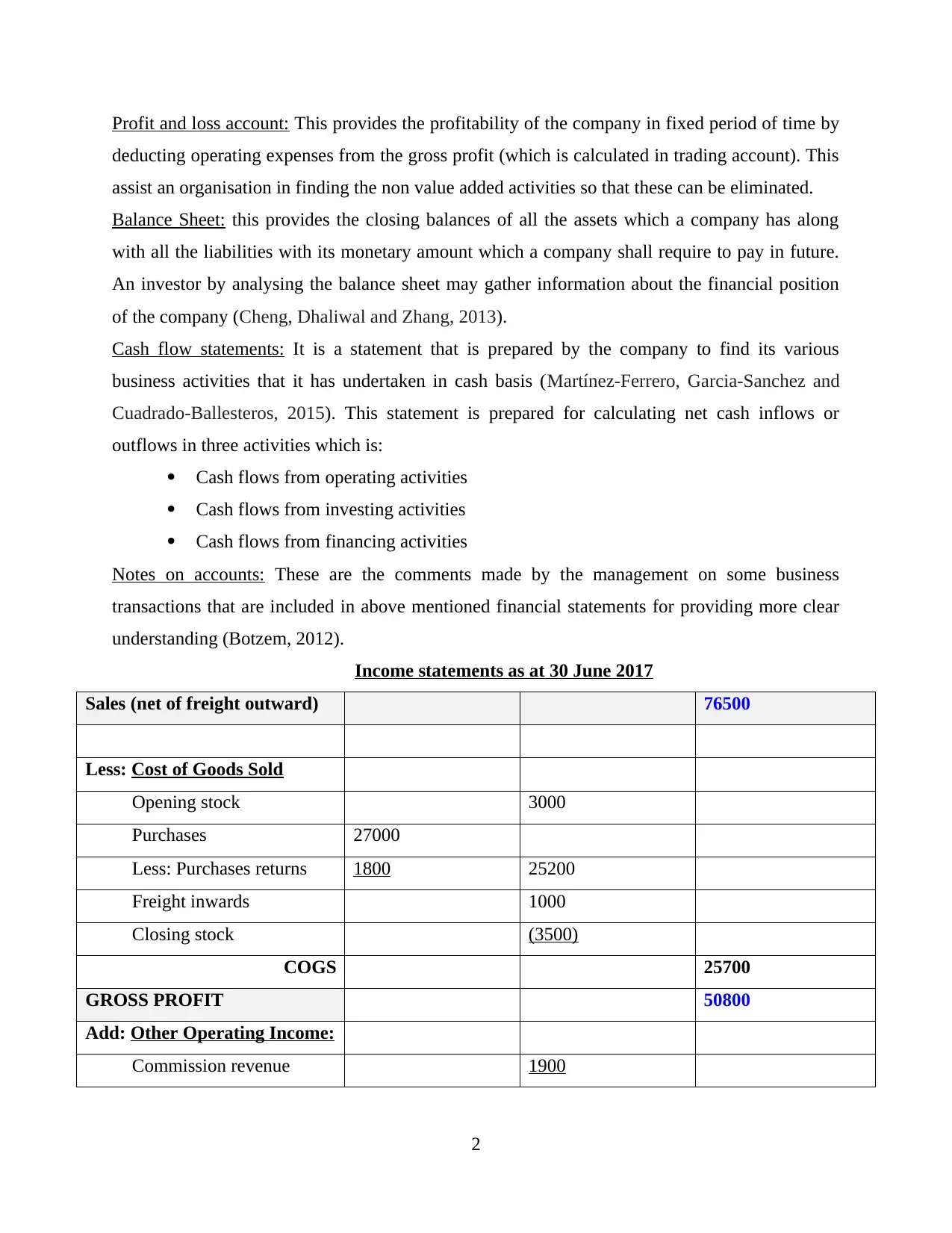
Profit and loss account: This provides the profitability of the company in fixed period of time by
deducting operating expenses from the gross profit (which is calculated in trading account). This
assist an organisation in finding the non value added activities so that these can be eliminated.
Balance Sheet: this provides the closing balances of all the assets which a company has along
with all the liabilities with its monetary amount which a company shall require to pay in future.
An investor by analysing the balance sheet may gather information about the financial position
of the company (Cheng, Dhaliwal and Zhang, 2013).
Cash flow statements: It is a statement that is prepared by the company to find its various
business activities that it has undertaken in cash basis (Martínez‐Ferrero, Garcia‐Sanchez and
Cuadrado‐Ballesteros, 2015). This statement is prepared for calculating net cash inflows or
outflows in three activities which is:
Cash flows from operating activities
Cash flows from investing activities
Cash flows from financing activities
Notes on accounts: These are the comments made by the management on some business
transactions that are included in above mentioned financial statements for providing more clear
understanding (Botzem, 2012).
Income statements as at 30 June 2017
Sales (net of freight outward) 76500
Less: Cost of Goods Sold
Opening stock 3000
Purchases 27000
Less: Purchases returns 1800 25200
Freight inwards 1000
Closing stock (3500)
COGS 25700
GROSS PROFIT 50800
Add: Other Operating Income:
Commission revenue 1900
2
deducting operating expenses from the gross profit (which is calculated in trading account). This
assist an organisation in finding the non value added activities so that these can be eliminated.
Balance Sheet: this provides the closing balances of all the assets which a company has along
with all the liabilities with its monetary amount which a company shall require to pay in future.
An investor by analysing the balance sheet may gather information about the financial position
of the company (Cheng, Dhaliwal and Zhang, 2013).
Cash flow statements: It is a statement that is prepared by the company to find its various
business activities that it has undertaken in cash basis (Martínez‐Ferrero, Garcia‐Sanchez and
Cuadrado‐Ballesteros, 2015). This statement is prepared for calculating net cash inflows or
outflows in three activities which is:
Cash flows from operating activities
Cash flows from investing activities
Cash flows from financing activities
Notes on accounts: These are the comments made by the management on some business
transactions that are included in above mentioned financial statements for providing more clear
understanding (Botzem, 2012).
Income statements as at 30 June 2017
Sales (net of freight outward) 76500
Less: Cost of Goods Sold
Opening stock 3000
Purchases 27000
Less: Purchases returns 1800 25200
Freight inwards 1000
Closing stock (3500)
COGS 25700
GROSS PROFIT 50800
Add: Other Operating Income:
Commission revenue 1900
2
Paraphrase This Document
Need a fresh take? Get an instant paraphrase of this document with our AI Paraphraser
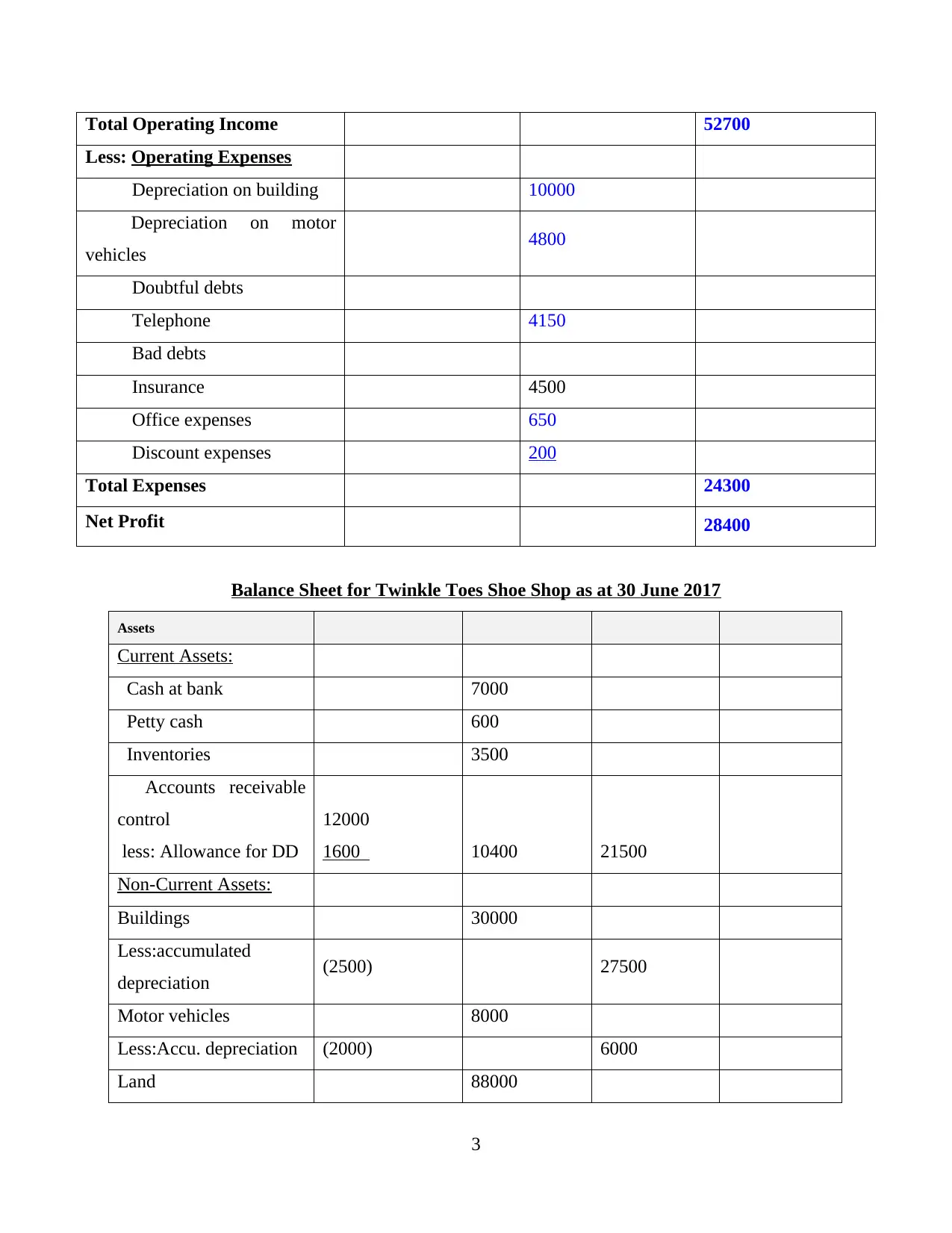
Total Operating Income 52700
Less: Operating Expenses
Depreciation on building 10000
Depreciation on motor
vehicles 4800
Doubtful debts
Telephone 4150
Bad debts
Insurance 4500
Office expenses 650
Discount expenses 200
Total Expenses 24300
Net Profit 28400
Balance Sheet for Twinkle Toes Shoe Shop as at 30 June 2017
Assets
Current Assets:
Cash at bank 7000
Petty cash 600
Inventories 3500
Accounts receivable
control
less: Allowance for DD
12000
1600 10400 21500
Non-Current Assets:
Buildings 30000
Less:accumulated
depreciation (2500) 27500
Motor vehicles 8000
Less:Accu. depreciation (2000) 6000
Land 88000
3
Less: Operating Expenses
Depreciation on building 10000
Depreciation on motor
vehicles 4800
Doubtful debts
Telephone 4150
Bad debts
Insurance 4500
Office expenses 650
Discount expenses 200
Total Expenses 24300
Net Profit 28400
Balance Sheet for Twinkle Toes Shoe Shop as at 30 June 2017
Assets
Current Assets:
Cash at bank 7000
Petty cash 600
Inventories 3500
Accounts receivable
control
less: Allowance for DD
12000
1600 10400 21500
Non-Current Assets:
Buildings 30000
Less:accumulated
depreciation (2500) 27500
Motor vehicles 8000
Less:Accu. depreciation (2000) 6000
Land 88000
3

Shares in XYZ LTD 15000
Goodwill 12000 115000
Total Assets 171600 170,000
Less Liabilities
Current Liabilities:
Accounts payable
Control 12850
GST Collected 2000 14850
Non-Current Liabilities:
Mortgage 27000
Total Liabilities 41850
Net Assets 128150
Owners’ Equity
Capital 101350
Less: drawings 1600
99750
Add: Net profit 28400
Total Owners Equity 128150
Preparation of financial statements of Brisbane Camping World:
General Journal
Date Details Debit Credit
Sales A/c Dr. 183440
To Trading A/c 183440
(Being revenues transferred)
Trading A/c Dr. 110802
To COGS A/c 110802
4
Goodwill 12000 115000
Total Assets 171600 170,000
Less Liabilities
Current Liabilities:
Accounts payable
Control 12850
GST Collected 2000 14850
Non-Current Liabilities:
Mortgage 27000
Total Liabilities 41850
Net Assets 128150
Owners’ Equity
Capital 101350
Less: drawings 1600
99750
Add: Net profit 28400
Total Owners Equity 128150
Preparation of financial statements of Brisbane Camping World:
General Journal
Date Details Debit Credit
Sales A/c Dr. 183440
To Trading A/c 183440
(Being revenues transferred)
Trading A/c Dr. 110802
To COGS A/c 110802
4
⊘ This is a preview!⊘
Do you want full access?
Subscribe today to unlock all pages.

Trusted by 1+ million students worldwide
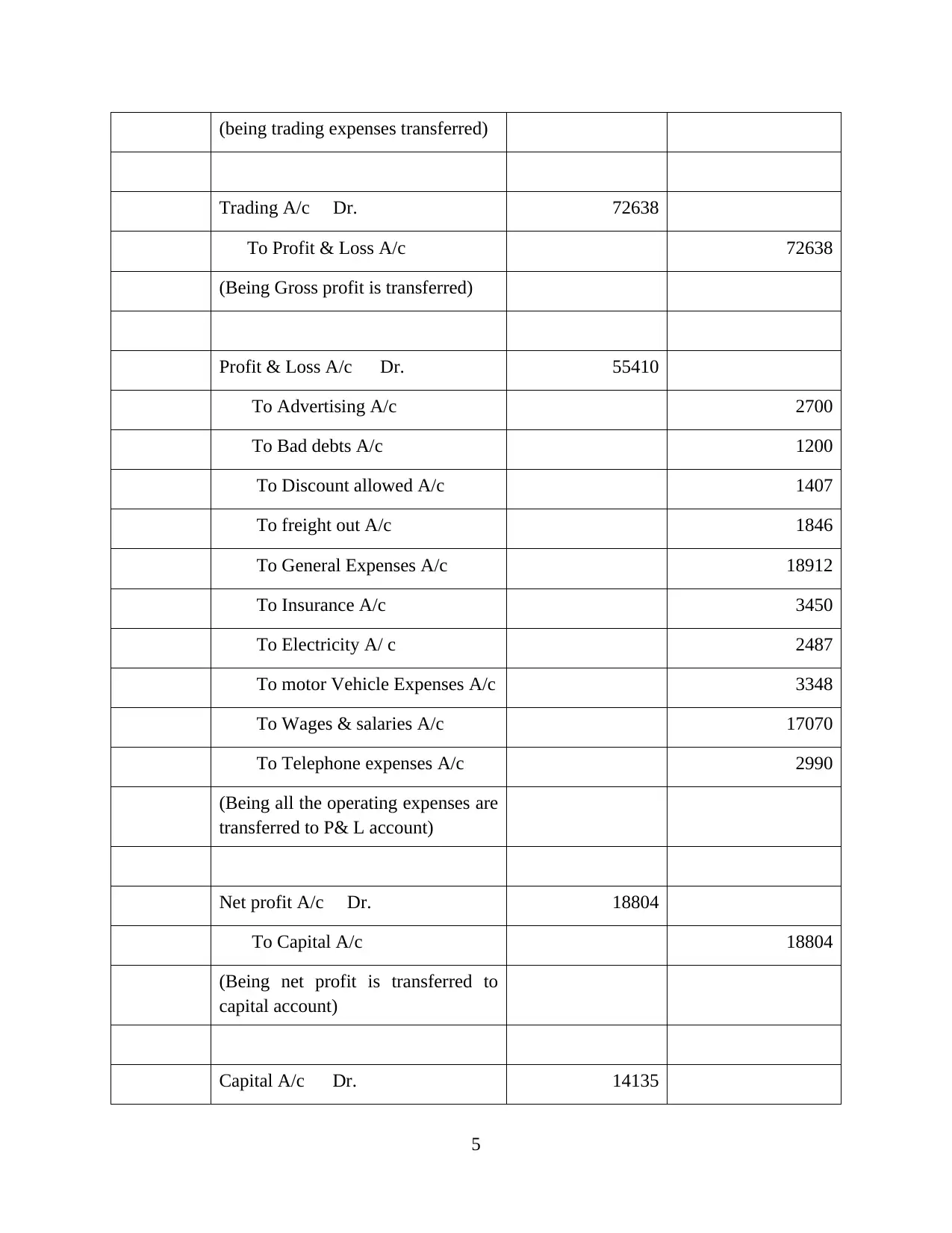
(being trading expenses transferred)
Trading A/c Dr. 72638
To Profit & Loss A/c 72638
(Being Gross profit is transferred)
Profit & Loss A/c Dr. 55410
To Advertising A/c 2700
To Bad debts A/c 1200
To Discount allowed A/c 1407
To freight out A/c 1846
To General Expenses A/c 18912
To Insurance A/c 3450
To Electricity A/ c 2487
To motor Vehicle Expenses A/c 3348
To Wages & salaries A/c 17070
To Telephone expenses A/c 2990
(Being all the operating expenses are
transferred to P& L account)
Net profit A/c Dr. 18804
To Capital A/c 18804
(Being net profit is transferred to
capital account)
Capital A/c Dr. 14135
5
Trading A/c Dr. 72638
To Profit & Loss A/c 72638
(Being Gross profit is transferred)
Profit & Loss A/c Dr. 55410
To Advertising A/c 2700
To Bad debts A/c 1200
To Discount allowed A/c 1407
To freight out A/c 1846
To General Expenses A/c 18912
To Insurance A/c 3450
To Electricity A/ c 2487
To motor Vehicle Expenses A/c 3348
To Wages & salaries A/c 17070
To Telephone expenses A/c 2990
(Being all the operating expenses are
transferred to P& L account)
Net profit A/c Dr. 18804
To Capital A/c 18804
(Being net profit is transferred to
capital account)
Capital A/c Dr. 14135
5
Paraphrase This Document
Need a fresh take? Get an instant paraphrase of this document with our AI Paraphraser
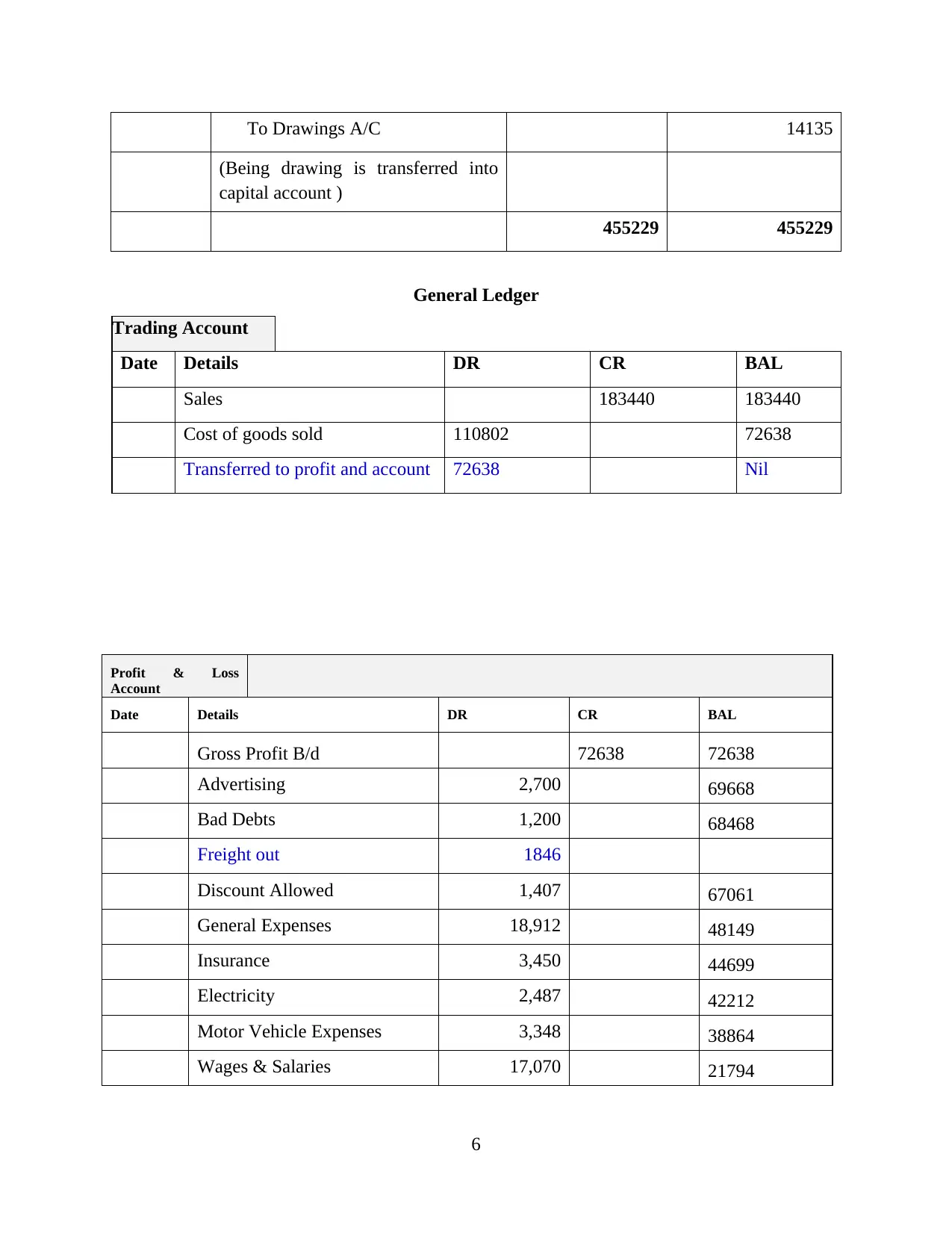
To Drawings A/C 14135
(Being drawing is transferred into
capital account )
455229 455229
General Ledger
Trading Account
Date Details DR CR BAL
Sales 183440 183440
Cost of goods sold 110802 72638
Transferred to profit and account 72638 Nil
Profit & Loss
Account
Date Details DR CR BAL
Gross Profit B/d 72638 72638
Advertising 2,700 69668
Bad Debts 1,200 68468
Freight out 1846
Discount Allowed 1,407 67061
General Expenses 18,912 48149
Insurance 3,450 44699
Electricity 2,487 42212
Motor Vehicle Expenses 3,348 38864
Wages & Salaries 17,070 21794
6
(Being drawing is transferred into
capital account )
455229 455229
General Ledger
Trading Account
Date Details DR CR BAL
Sales 183440 183440
Cost of goods sold 110802 72638
Transferred to profit and account 72638 Nil
Profit & Loss
Account
Date Details DR CR BAL
Gross Profit B/d 72638 72638
Advertising 2,700 69668
Bad Debts 1,200 68468
Freight out 1846
Discount Allowed 1,407 67061
General Expenses 18,912 48149
Insurance 3,450 44699
Electricity 2,487 42212
Motor Vehicle Expenses 3,348 38864
Wages & Salaries 17,070 21794
6
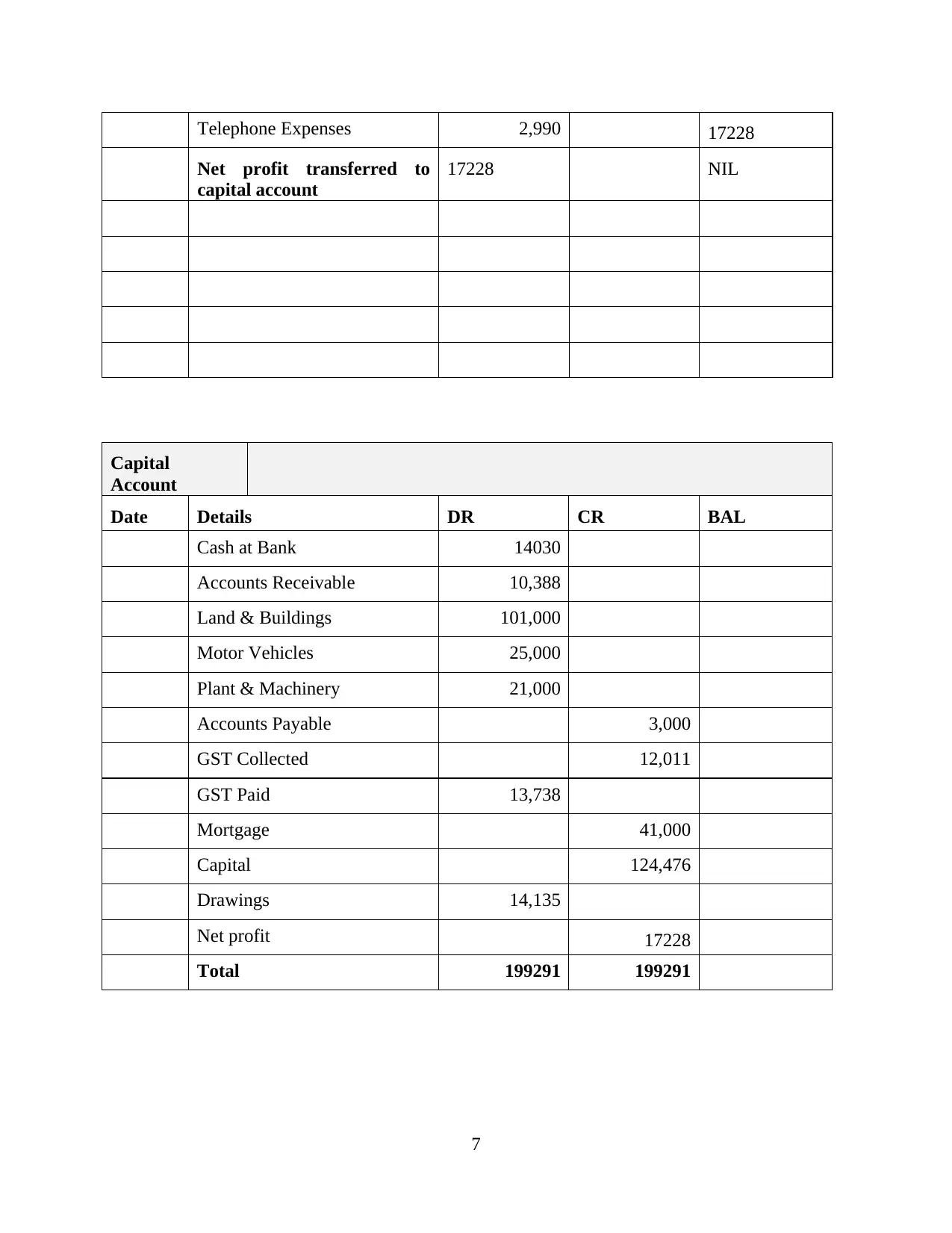
Telephone Expenses 2,990 17228
Net profit transferred to
capital account
17228 NIL
Capital
Account
Date Details DR CR BAL
Cash at Bank 14030
Accounts Receivable 10,388
Land & Buildings 101,000
Motor Vehicles 25,000
Plant & Machinery 21,000
Accounts Payable 3,000
GST Collected 12,011
GST Paid 13,738
Mortgage 41,000
Capital 124,476
Drawings 14,135
Net profit 17228
Total 199291 199291
7
Net profit transferred to
capital account
17228 NIL
Capital
Account
Date Details DR CR BAL
Cash at Bank 14030
Accounts Receivable 10,388
Land & Buildings 101,000
Motor Vehicles 25,000
Plant & Machinery 21,000
Accounts Payable 3,000
GST Collected 12,011
GST Paid 13,738
Mortgage 41,000
Capital 124,476
Drawings 14,135
Net profit 17228
Total 199291 199291
7
⊘ This is a preview!⊘
Do you want full access?
Subscribe today to unlock all pages.

Trusted by 1+ million students worldwide
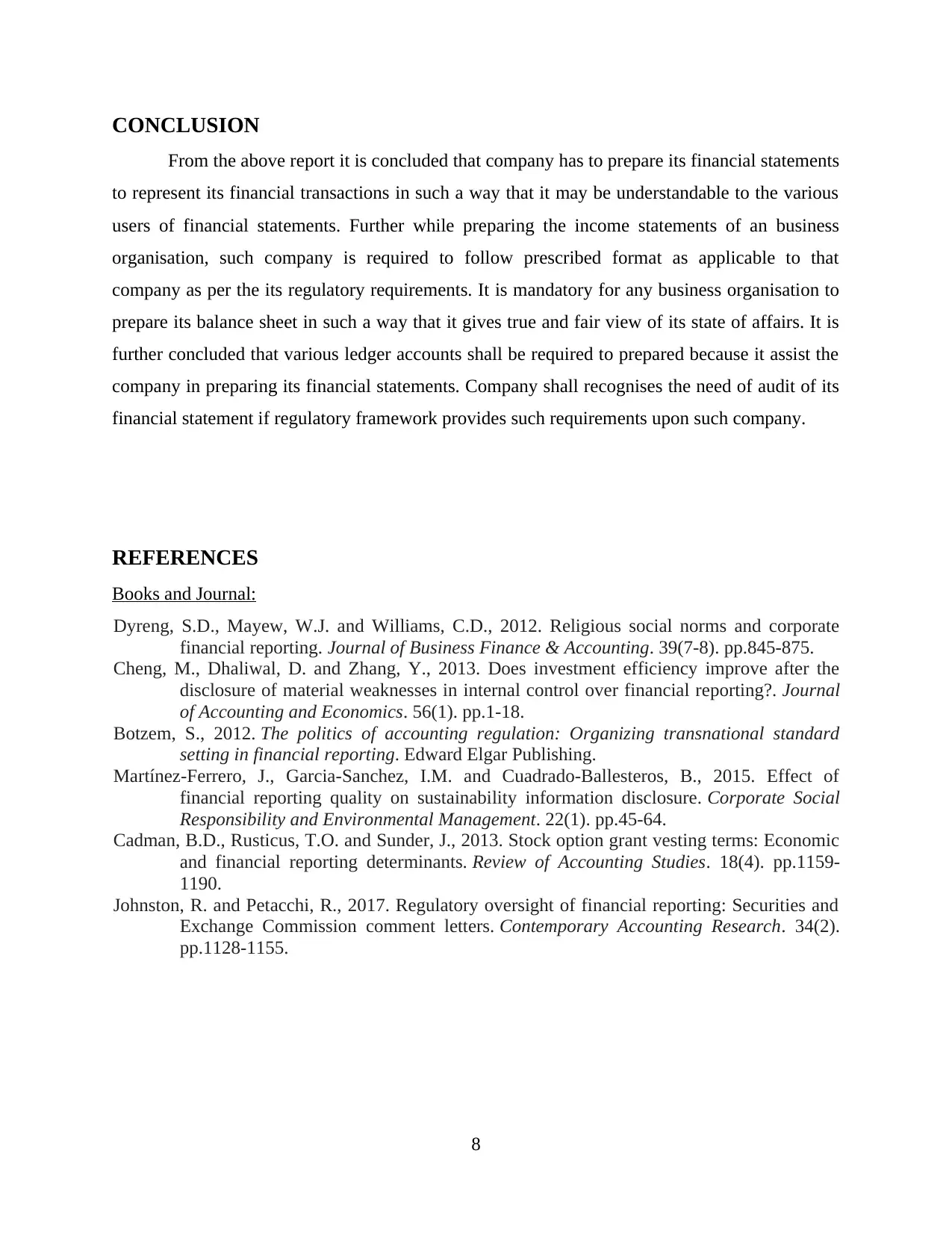
CONCLUSION
From the above report it is concluded that company has to prepare its financial statements
to represent its financial transactions in such a way that it may be understandable to the various
users of financial statements. Further while preparing the income statements of an business
organisation, such company is required to follow prescribed format as applicable to that
company as per the its regulatory requirements. It is mandatory for any business organisation to
prepare its balance sheet in such a way that it gives true and fair view of its state of affairs. It is
further concluded that various ledger accounts shall be required to prepared because it assist the
company in preparing its financial statements. Company shall recognises the need of audit of its
financial statement if regulatory framework provides such requirements upon such company.
REFERENCES
Books and Journal:
Dyreng, S.D., Mayew, W.J. and Williams, C.D., 2012. Religious social norms and corporate
financial reporting. Journal of Business Finance & Accounting. 39(7‐8). pp.845-875.
Cheng, M., Dhaliwal, D. and Zhang, Y., 2013. Does investment efficiency improve after the
disclosure of material weaknesses in internal control over financial reporting?. Journal
of Accounting and Economics. 56(1). pp.1-18.
Botzem, S., 2012. The politics of accounting regulation: Organizing transnational standard
setting in financial reporting. Edward Elgar Publishing.
Martínez‐Ferrero, J., Garcia‐Sanchez, I.M. and Cuadrado‐Ballesteros, B., 2015. Effect of
financial reporting quality on sustainability information disclosure. Corporate Social
Responsibility and Environmental Management. 22(1). pp.45-64.
Cadman, B.D., Rusticus, T.O. and Sunder, J., 2013. Stock option grant vesting terms: Economic
and financial reporting determinants. Review of Accounting Studies. 18(4). pp.1159-
1190.
Johnston, R. and Petacchi, R., 2017. Regulatory oversight of financial reporting: Securities and
Exchange Commission comment letters. Contemporary Accounting Research. 34(2).
pp.1128-1155.
8
From the above report it is concluded that company has to prepare its financial statements
to represent its financial transactions in such a way that it may be understandable to the various
users of financial statements. Further while preparing the income statements of an business
organisation, such company is required to follow prescribed format as applicable to that
company as per the its regulatory requirements. It is mandatory for any business organisation to
prepare its balance sheet in such a way that it gives true and fair view of its state of affairs. It is
further concluded that various ledger accounts shall be required to prepared because it assist the
company in preparing its financial statements. Company shall recognises the need of audit of its
financial statement if regulatory framework provides such requirements upon such company.
REFERENCES
Books and Journal:
Dyreng, S.D., Mayew, W.J. and Williams, C.D., 2012. Religious social norms and corporate
financial reporting. Journal of Business Finance & Accounting. 39(7‐8). pp.845-875.
Cheng, M., Dhaliwal, D. and Zhang, Y., 2013. Does investment efficiency improve after the
disclosure of material weaknesses in internal control over financial reporting?. Journal
of Accounting and Economics. 56(1). pp.1-18.
Botzem, S., 2012. The politics of accounting regulation: Organizing transnational standard
setting in financial reporting. Edward Elgar Publishing.
Martínez‐Ferrero, J., Garcia‐Sanchez, I.M. and Cuadrado‐Ballesteros, B., 2015. Effect of
financial reporting quality on sustainability information disclosure. Corporate Social
Responsibility and Environmental Management. 22(1). pp.45-64.
Cadman, B.D., Rusticus, T.O. and Sunder, J., 2013. Stock option grant vesting terms: Economic
and financial reporting determinants. Review of Accounting Studies. 18(4). pp.1159-
1190.
Johnston, R. and Petacchi, R., 2017. Regulatory oversight of financial reporting: Securities and
Exchange Commission comment letters. Contemporary Accounting Research. 34(2).
pp.1128-1155.
8
1 out of 10
Related Documents
Your All-in-One AI-Powered Toolkit for Academic Success.
+13062052269
info@desklib.com
Available 24*7 on WhatsApp / Email
![[object Object]](/_next/static/media/star-bottom.7253800d.svg)
Unlock your academic potential
Copyright © 2020–2025 A2Z Services. All Rights Reserved. Developed and managed by ZUCOL.




